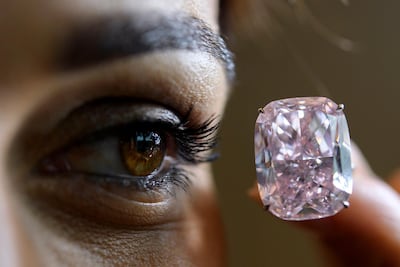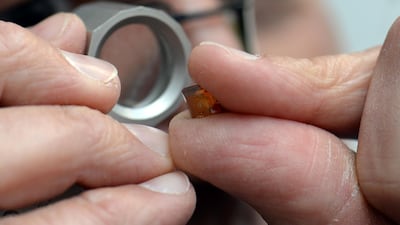Diamonds were forged billions of years ago deep within the earth's crust, making them rare and coveted throughout the ages. Lab grown stones however are fast becoming so good that even experts cannot tell which is real and which comes from a factory.
This is a problem for the industry as well as investors because lab diamonds are getting to the point where they are jewellery quality, something that threatens to devalue collections the world over.
"Lab-grown diamonds are now the single greatest existential threat to the industry," says Peter Meeus, former chairman of the Dubai Diamond Exchange. Mr Meeus helped establish the DDE during which time it has become the third largest centre worldwide for rough diamond trade, after Mumbai and Antwerp. The DDE now trades around US$26 billion in diamonds each year.
Speaking on the sidelines at a mining conference in Cape Town recently, Mr Meeus says diamonds from nature should not be replaced by those created by men in white coats.
"At the time in life when authenticity matters, such as marriage, owning the real thing counts. And always make sure to certify before you buy. That way you know you are getting the real thing."
Mr Meeus says some labs are marketing their diamond products as 'green' or 'eco-friendly', with celebrities such as Leonardo Dicaprio backing lab diamonds, helping them become respectable.
"Some are calling them 'conflict free,” Mr Meeus adds in reference to the association of gems used by warlords, mercenaries and opportunists to fund their activities, especially across Africa.
Currently synthetic diamonds costs about a third less per carat than the real thing, and are expected to get even cheaper as the technology evolves. This allows unscrupulous dealers to profit handsomely by passing them off as authentic.
So, should diamond investors be concerned?
Part of the allure of natural diamonds is how nature created them. When the world was still young, intense heat and pressure caused carbon atoms to crystallise into diamonds. By the 19th century scientists had discovered ways to replicate the process but the results were crude and of little threat to collectors of fine, flawless jewels.
The technology has now taken a quantum leap forward, and laboratories from the US to India are producing diamonds so good that even experts are fooled. As a result, the industry is headed for an technological race as it develops new methods to detect artificial jewels from the real thing.
"It was only five years ago that the first engagement-ring quality diamonds were made," says Mr Meeus. "Just two years before that it was believed there was no chance of synthetic diamonds being cost effective."
The thinking at the time was that although quality of lab diamonds had improved, the process involved was too expensive to catch on.
Which means the global diamond chain had to adapt to the threat from synthetic diamonds that were being marketed at consumers with a conscience.
"Our research shows millennials - people under the age of 35 – have different priorities when making purchases," says Sahag Arslanian, head of the Arslanian Group, an Antwerp based diamond-trading house whose origins lie in Lebanon.
"They have values that will have them ask 'where does this come from."
Since Millennials represent the new generation of potential diamond collectors, their loss to synthetics would be a wounding blow to the natural industry.
In particular millennials are extremely aware of the risk of consumers inflicting harm by buying products with unethical origins, such as blood diamonds.
In 2003 the worldwide diamond industry set up the Kimberly Process to vet the origins of all of the stones that were produced. Currently the largest suppliers of diamonds are countries that are at peace, such as Russia, Canada, Australia and in Africa, Botswana, Namibia and Lesotho.
The Democratic Republic of Congo is probably the biggest provider of diamonds that is still mired in conflict. Angola though, once bogged down in bloody civil war is now at peace. But most of the industry itself is scattered around the world in conflict-free countries, from India to Africa to the UAE.
Among the so-called millennial generation social awareness is high. Combined with a love of technology, the appeal of lab diamonds is high among this group, Mr Arslanian says.
"It is a generation that loves disruption, that has made Uber a success. They've even made fake fur trendy again."
He points to a San Francisco, US firm called Foundry Diamonds that produces synthetics in its own laboratories. The firm includes Oscar winning actor Leonardo Dicaprio among its celebrity investors, and plays up its American roots.
"Unlike earth extraction from underground in Africa or Russia, ours are created above the ground in America with a zero-carbon footprint," Foundry says on its website. Foundry did not respond to a request for comment.
Foundry at least openly markets its products as synthetic, but not all do so. India is now in the midst of one of its biggest ever financial scandals involving billionaire Nirav Modi, whom the Financial Times once described as "India's most celebrated jewellery baron."
______
Read more:
Miner unearths diamonds of more than 100 carats in Lesotho
Diamonds are a risk-free investment
$1.8bn Indian fraud causes jewellery trade pain
______
Mr Modi is now the centre of a $2 billion securities fraud investigation by Indian authorities. Among other activities of which he is suspected is the salting of regular diamond sales with the lab grown variety.
The allegations have sent a wave of panic through the Indian diamond market, which depends on the cutting and polishing up to 90 per cent of the world's diamonds. The diamond industry is utterly dependent on trust with deals of millions of dollars closed on little more than a handshake.
Indian media reports that some of the country's largest firms are considering upping stakes and moving to Belgium or Dubai.
The unfolding scandal will only add pressure to an industry that needs to rebuild relevance in a changing world. Kent Wong Siu Kee, managing director of Hong Kong based Chow Tai Fook Jewellery Group, says thus far the Asia market is holding strong. "But we still need to figure out how to sell the diamond story to millennials," he adds.
The company is now setting up a system that will track the life cycle of a diamond, from when it first emerges from the ground at a mine.
"The aim is to put information in the hands of the customer. With an app the client can track the history of a diamond every step of the way," Mr Kee adds. "It will be possible to track a piece of jewellery to its point of origin in say, Botswana, or wherever it originates from."
The industry meanwhile is developing technology to scan and classify diamonds. Companies such as de Beers, which pioneered the world diamond market and whose clever advertising invented the tradition of the wedding ring are spending millions of dollars developing technology.
Producers will also have to change the way they operate. Right now mining companies unearth diamonds that range from flawless to complete crud. The latter are packaged for industrial use or cut to produce small stones used in costume jewellery.
Firms such as de Beers control the flow and quality of diamonds released onto the market, which has led to the perception that the scarcity is artificial. In total around 1.1 million diamonds are polished for market each year, according to Mr Meeus.
However, there has not been a significant new diamond source discovered in decades. Virtually all production now come from deposits discovered before the 1990s. In its heyday a century ago South Africa produced 95 per cent of the world's diamonds, with three tonnes alone coming from the Kimberly 'Big Hole.'
Today the 'Big Hole' is a forlorn tourist attraction and it is mostly left to producers in other countries such as Lesotho, Botswana and Namibia to service world demand.
Every now and then an awe-inducing stone is discovered and reaches a fabulous auction price, such as the 910-carat 'Lesotho Legend' that Gem Diamond sold at auction earlier this month for US$40m. The same week the company said it had discovered another above-100 carat stone at its Lesotho operation, this one coming in at 169 carats.
Over time such finds will grow ever rarer as existing mines are worked out. Jewel-class diamonds will become pricier, even as machine made gems become cheaper and more authentic.

Reconciling the two trends may be difficult, but not impossible believes New York based diamond analyst Paul Zimnisky. He says there is room for cheap costume-type diamonds as well as once-in-a lifetime purchases of the genuine thing.
"A woman may get an $8,000 wedding ring to treasure for the rest of her life. But for less emotional purchases, such as a pair of diamond studded earrings go for a cheap $400 pair that can be worn on a night out."
For now though, the natural diamond industry itself is going to double down on its old-school appeal and try win over the most challenging of markets – the millennials.
Mr Meeus says a diamond grown in the lab cannot compare with the real thing any more than an exact replica Hermes handbag can with an original, no matter how good the quality.
"An original diamond was made three billion years ago," Mr Meeus says. "That's older than the dinosaurs – older than life itself. You can't grow that in a laboratory."


